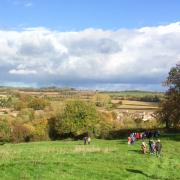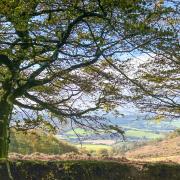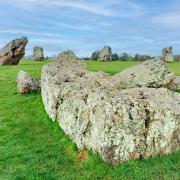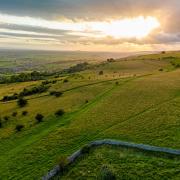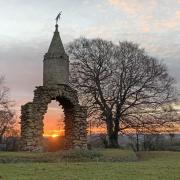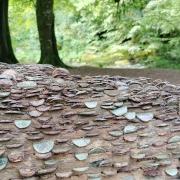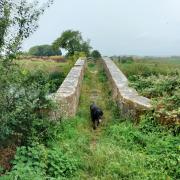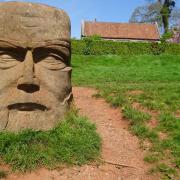SIMONE STANBROOK-BYRNE finds a selection of places to wander where we can enjoy spring flowers during the next few months.

February: long nights, cold and dreary days. Winter at its grimmest. Will it ever end?
Then suddenly there is a glimmer of something bright. A little botanical angel sent by Mother Nature to remind us that spring is round the corner and the world will wake up again.
Snowdrops are often regarded as the early heralds of spring but sometimes primroses and daffodils appear even earlier than snowdrops, with bluebells coming later in the season.
Whatever appears first, and wherever they are found, they are a welcome signal that the days are lengthening and that somewhere, up there above the clouds, the sun is shining.
Two things to remember:
Firstly, the flowering times for any plant can vary according to conditions each year, as can the abundance of the show they put on for us.
And, secondly, these spring flowers are not for picking: they are to be left for others to enjoy after you.
For each of the following walks check the website/map prior to setting out, so that you can tailor your visit to suit how far you wish to walk.
Snowdrop Valley, near Wheddon Cross, Exmoor
One of the best-known places in the county for snowdrops, this privately-owned valley is open to the public each February, when the snowdrops appear in a shimmering confection to carpet the woodland floor.
The original plants here were probably introduced by monks from Dunster, for whom the flowers were a symbol of the Feast of Candlemas on 2 February; snowdrops are sometimes known, rather musically, as Candlemas Bells.
The Snowdrop Valley website gives details of several walking routes from Wheddon Cross to the valley, and buses run for those who prefer not to walk. It is an extremely well-organised operation and deeply popular - so expect mud.
For those wanting a less populous walk, Wheddon Cross is served by a wealth of footpaths and bridleways, and is just three miles by road from Dunkery Beacon, the highest point on Exmoor. Pockets of snowdrops will be encountered throughout the area during February. Check the website for Snowdrop Valley opening dates and details of refreshments, buses etc. Parking is at Wheddon Cross, not in the valley.
W: wheddoncross.org.uk/snowdropvalley
Map: OS Explorer OL9 Exmoor 1:25 000
Grid Ref (of Wheddon Cross): SS924388
Prior Park, near Bath
This beautiful, 18th century landscape garden is in the care of the National Trust. There are various options for walks around, and from, the gardens, depending on your energy levels.
Prior Park is known for its swathes of spring flowers: snowdrops, daffodils, primroses and a rich abundance of wild garlic - the leaves of which are used by the kitchen, so if you visit at the right time you could be sampling the plants for lunch. The restoration of the garden is on-going, so you may see evidence of this.
There are many organised activities throughout the year at Prior Park.
Note: there is a National Trust entry charge for non-members
W: nationaltrust.org.uk/prior-park-landscape-garden
Map: OS Explorer 155 Bristol and Bath 1:25 000
Address: Ralph Allen Drive, Bath, Somerset, BA2 5AH
King's Castle Wood, near Wells
A SWT reserve in the Mendips, where wildlife rubs shoulders with history on an Iron Age hillfort. Bluebells and dogs mercury are abundant in spring, with several rarer species such as delightful Solomon's seal, which is in flower from mid spring. This is another site that
will also appeal to bird watchers: the reserve is home to important nesting birds including marsh tit and wood warbler. Also look out for signs of deer and badgers.
There is no car park near this site so you need to be prepared to follow footpaths to get there, so access details on the website.
While in the area, a stroll round the delightful cathedral city of Wells, England's smallest city, is also a good idea and there are free guided tours around the cathedral.
W: somersetwildlife.org/kings_castle_wood
Map: OS Explorer 141 Cheddar Gorge and Mendip Hills West 1:25 000
Grid ref: ST 568456
Cheddar Complex Nature Reserves
The SWT also manages three sites near the eastern end of Cheddar Gorge, which make up the 'Cheddar Complex'. The first time I visited I was captivated by the name Velvet Bottom, one of the three reserves, the other two being Black Rock and Long Wood. Long Wood has been cared for by the trust since 1969 and, in late spring, is very good for bluebells and aromatic wild garlic.
One of the SWT's volunteer groups, the Magnificent Meadows team, will have been working at Long Wood during January to remove encroaching hawthorn growth from the orchid slope, and to coppice back small blocks of scrub and hazel. Coppicing is a traditional method of woodland management which cuts certain trees down to almost ground level, from which they will send up new growth.
There are footpaths throughout these reserves; go quietly, tread softly, you may see deer. The website gives details of access and there is limited parking beside the road at Black Rock.
While in the area, a walk along the top of, or through, Cheddar Gorge is a must, for dramatic scenery and superb views.
W: somersetwildlife.org/cheddar_complex
Map: OS Explorer 141 Cheddar Gorge and Mendip Hills West 1:25 000
Grid ref: ST 484545
Thurlbear Wood, near Stoke St Mary
Here in Somerset we are indebted to the Somerset Wildlife Trust (SWT) for its conservation work and preservation of a wide range of habitats. Thurlbear Wood is one such site, a lovely ancient woodland and part of a Site of Special Scientific Interest. It is traversed by ancient ways and is rich with flora and fauna that varies with the season; look out for wood anemone from March to May, as well as violets, primroses and bluebells, plus less-common species. Later in the season there are orchids.
Animal life is also abundant though can be harder to spot. Dormice, hares and roe deer are here, along with an excellent range of birds. Bats flit about at dusk. Listen out for great spotted woodpeckers and the 'shrillet' squealings of foraging shrews.
During the autumn conservation volunteers undertook much work at Thurlbear Wood, cutting and raking the rides and glades, so you can appreciate their efforts as you stroll.
For directions, access and parking see their website.
W: somersetwildlife.org/thurlbear_wood
Map: OS Explorer 128 Taunton and the Blackdown Hills 1:25,000
Grid ref: ST 273213.
Beer and Aller Woods, between Othery and Langport
Unusually, these SWT reserves are adjacent to an army rifle range, so you may be aware of activity there. The woodlands are rich with wood anemone early in spring, followed by bluebells later on.
A footpath leads from Aller village, or access can be gained through National Trust woodland at the north end. Parking is very limited.
W: somersetwildlife.org/aller_beer_woods
Map: The footpath from Aller straddles two OS Explorer maps: 141 Cheddar Gorge and Mendip Hills West 1:25 000 and 129 Yeovil & Sherborne 1:25 000
Grid ref: ST 405306 (Aller Wood)/ST 414317 (Beer Wood)
Simone Stanbrook-Byrne is the author, with James Clancy, of 'A Dozen Dramatic Walks in Somerset' and other walking guides for the West Country.




